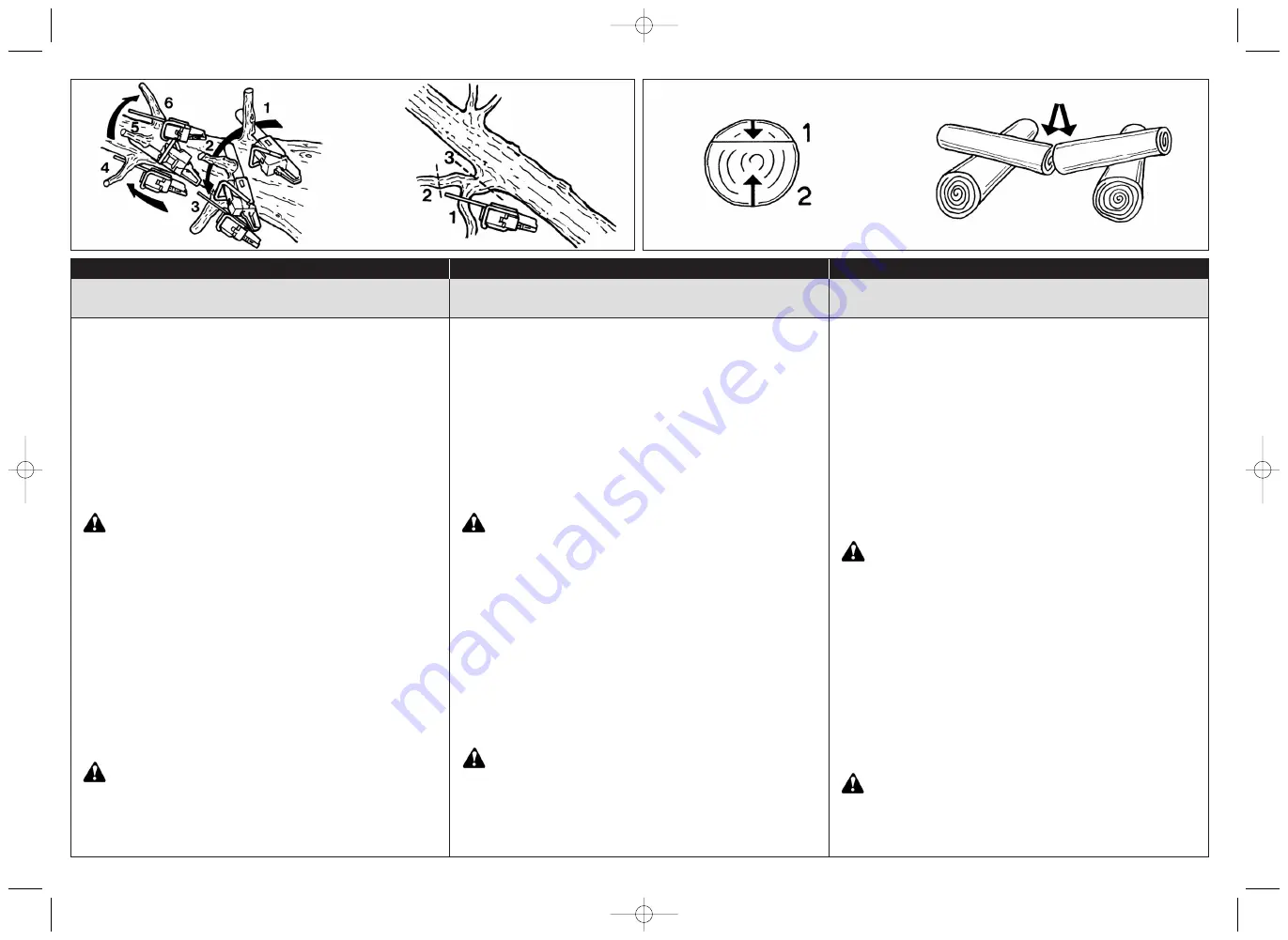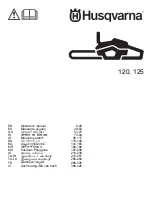
22
46
45
SRAMATURA
a) Partire sempre dal diametro maggiore andando verso la
punta per sramare la pianta o eventuali rami secondari.
b) Cercare sempre la posizione più stabile e sicura prima di
accelerare la motosega. Se occorre, mantenere l’equilibrio
appoggiando il ginocchio più vicino al tronco stesso.
c) Tenere la motosega appoggiata al tronco per non affati-
carsi eccessivamente, ruotandola sul lato sinistro o destro
a seconda della posizione del ramo da tagliare (Fig. 45).
d) Nel caso di rami sotto tensione cercare una posizione si-
cura per proteggersi dall’eventuale colpo di frusta. Iniziare
sempre il taglio dalla parte opposta alla piegatura.
ATTENZIONE - Non usare il bordo superiore della
punta della barra soprattutto per sramare perchè
si corre il rischio di ricevere un contraccolpo.
SEZIONATURA
Prima di iniziare a sezionare il tronco guardare come que-
sto è appoggiato al suolo; questo permetterà di tagliarlo nel
modo corretto evitando che la barra rimanga bloccata in
mezzo al tronco.
a) Iniziare a tagliare nella parte superiore per circa 1/4 del
diametro (1 - Fig. 46). Finire il taglio dalla parte inferiore (2
- Fig. 46). In questo modo il taglio sarà perfetto e la barra
non rimarrà bloccata nel tronco.
b) Iniziare il taglio nella parte inferiore per circa 1/4 del dia-
metro (1 - Fig. 47). Finire il taglio dalla parte superiore (2 -
Fig. 47).
ATTENZIONE - Se il legno si chiude sulla catena
durante il taglio, fermare il motore, alzare il tronco
e cambiargli posizione (Fig. 48). Non cercare di li-
berare la catena tirando l’impugnatura della moto-
sega.
LIMBING
a) Always start from the larger diameter and move towards
the tip to cut off limbs and any secondary branches.
b) Always find the safest and most stable position before
accelerating the chain saw. If necessary, keep your balan-
ce by resting your knee on the trunk itself.
c) Keep the chain saw on the trunk so as not to get too ti-
red, turning it onto the left- or right-hand side depending on
the position of the branch to cut (Fig. 45).
d) In the case of branches under tension, find a safe posi-
tion to protect yourself if they whip back. Always start the
cut from the opposite side to the bend.
WARNING - Do not use the upper edge of the tip
of the guide bar to cross-cut; otherwise you might
risk a kickback.
BUCKING
When bucking up the trunk to desired lengths, there is one
basic rule to follow. Look to see where the trunk is suppor-
ted, and determine which way the two halves will fall when
cut.
a) If the trunk is supported at both ends, first make a small
cut at the top (1 - Fig. 46), then complete the cut from the
bottom (2 - Fig. 46). This will avoid pinching the saw.
b) If the trunk is supported at one end or near the center,
first make a small cut from underneath (1 - Fig. 47), then
complete the cut from the top (2 - Fig. 47).
WARNING - If the saw becomes pinched in the
trunk, stop the engine, lift the log and change its
position (Fig. 48). Never attempt to free the saw
by pulling on it.
EBRANCHAGE
a) Commencez toujours par le diamètre le plus grand en al-
lant vers la pointe pour ébrancher la plante ou d’éventuel-
les branches secondaires.
b) Cherchez toujours la position la plus stable et la plus sû-
re avant d’accélérer la tronçonneuse. Maintenez l’équilibre,
s’il le faut, en appuyant le genou plus proche du tronc.
c) Tenez la tronçonneuse appuyée au tronc pour ne pas
trop vous fatiguer, en tournant sur le côté gauche ou sur le
côté droit suivant la position de la branche à couper (Fig.
45).
d) Lorsque vous avez affaire à des branches sous tension,
cherchez une position sûre pour vous protéger d’éventuels
coups de fouet. Commencez toujours la coupe du côté op-
posé au pli.
ATTENTION - N’utilisez pas le bord supérieur de la
pointe du guide, surtout pour ébrancher, parce que
vous courez le risque de recevoir un contrecoup.
DEBITAGE
Avant de commencer à débiter le tronc, vérifiez la façon
dont il est appuyé au sol. Ceci permet de le couper de
façon correcte en évitant ainsi que le guide reste coincé au
milieu du tronc.
a) Commencez à couper la partie supérieure pour environ
1/4 du diamètre (1-Fig. 46). Terminez la coupe par la partie
inférieure (2-Fig. 46). De cette façon la coupe sera parfaite
et le guide ne restera pas coincé dans le tronc.
b) Commencez à couper la partie inférieure pour environ
1/4 du diamètre (1-Fig. 47). Terminez la coupe par la partie
supérieure (2-Fig. 47).
ATTENTION - Si le guide coince dans une entaille,
arrêtez le moteur, soulevez le tronc et changez-le
de position (Fig. 48). Ne tentez pas de libérer la
chaîne en tirant sur la poignée de la tronçonneu-
se.
Italiano
English
Français
SRAMATURA - SEZIONATURA
EBRANCHAGE - DEBITAGE
LIMBING - BUCKING
Impaginato 15-03-2005 15:10 Pagina 22











































